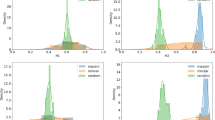Abstract
We consider the problem of maximizing terminal utility in a model where asset prices are driven by Wiener processes, but where the various rates of returns are allowed to be arbitrary semimartingales. The only information available to the investor is the one generated by the asset prices and, in particular, the return processes cannot be observed directly. This leads to an optimal control problem under partial information and for the cases of power, log, and exponential utility we manage to provide a surprisingly explicit representation of the optimal terminal wealth as well as of the optimal portfolio strategy. This is done without any assumptions about the dynamical structure of the return processes. We also show how various explicit results in the existing literature are derived as special cases of the general theory.
Similar content being viewed by others
References
Bäuerle N, Rieder U (2004) Portfolio optimization with Markov-modulated stock prices and interest rates. IEEE Trans Automat Control 49(3): 442–447
Bäuerle N, Rieder U (2005) Portfolio optimization with unobservable Markov-modulated drift process. J Appl Probab 42(2): 362–378
Bäuerle N, Rieder U (2007) Portfolio optimization with jumps and unobservable intensity. Math Financ 17(2): 205–224
Bensoussan A (2004) Stochastic control of partially-observable systems, 2nd edn. Cambridge University Press, Cambridge
Brendle S (2004) Portfolio selection under partial observation and constant absolute risk aversion, Working paper, Princeton University
Brendle S (2006) Portfolio selection under incomplete information. Stoch Process Appl 116(5): 701–723
Brennan M (1998) The role of learning in dynamic portfolio decisions. Eur Financ Rev 1:295–306
Brennan M, Xia Y (2001) Assessing asset pricing anomalies. Rev Financ Stud 14(4): 905–942
Callegaro G, Di Masi G, Runggaldier W (2006) Portfolio optimization in discontinuous markets under incomplete ionformation. Asia-Pac Financ Mark 13: 373–394
Cvitanic J, Lazrak A, Martinelli L, Zapatero F (2006) Dynamic portfolio choice with parameter uncertainty and the economic value of analysts’ recommendations. Rev Financ Stud 19: 1113–1156
Da Prato G, Zabzcyk J (1996) Ergodicity for infinite dimensional systems. Cambridge University Press, Cambridge
Dana R, Jeanblanc M (1992) Financial markets in continuous time. Cambridge University Press, Cambridge
Dothan M, Feldman D (1986) Equilibrium interest rates and multiperiod bonds in a partially observable economy. J Financ 41(2): 369–382
Feldman D (1989) The term structure of interest rates in a partially observed economy. J Financ 44: 789–812
Feldman D (1992) Logarithmic preferences, myopic decisions, and incomplete information. J Financ Quant Anal 27: 619–629
Feldman D (2003) Production and the real rate of interest: a sample path equilibrium. Rev Financ 7: 247–275
Feldman D (2007) Incomplete information equilibria: separation theorems and other myths. Ann Oper Res 151: 119–149
Fujisaki M, Kallianpur G, Kunita H (1972) Stochastic differential equations for the non linear filtering problem. Osaka J Math 9: 19–40
Gennotte G (1986) Optimal portfolio choice under incomplete information. J Financ 41: 733–749
Haussmann UG, Sass J (2004a) Optimal terminal wealth under partial information for HMM stock returns. In: Mathematics of finance (Contemp. Math. 351). AMS
Haussmann UG, Sass J (2004) Optimizing the terminal wealth under partial information: the drift process as a continuous time Markov chain. Financ Stoch 8: 553–577
Honda T (2003) Optimal portfolio choice for unobservable and regime-switching mean returns. J Econ Dyn Control 28: 45–78
Karatzas I, Lehoczky J, Shreve S (1987) Optimal portfolio and consumption decisions for a “small investor” on a finite horizon. SIAM J Control Optim 25: 1557–1586
Karatzas I, Shreve S (1998) Methods of mathematical finance. Springer, New York
Lakner P (1995) Utility maximization with partial information. Stoch Process Appl 56: 247–249
Lakner P (1998) Optimal trading strategy for an investor: the case of partial information. Stoch Process Appl 76: 77–97
Liptser R, Shiryayev A (2004) Statistics of random processes vol. I, 2nd edn. Springer, New York
Nagai H, Runggaldier W (2006) PDE approach to utility maximization for market models with hidden Markov factors. In: 5th Seminar on stochastic analysis, random fields and applications. Birkhauser Verlag
Rogers L, Williams D (1987) Diffusions, Markov processes and Martingales vol. 2. Wiley, New York
Sass J (2007) Utility maximization with convex constraints and partial information. Acta Appl Math 97: 221–238
Sass J, Wunderlich R (2009) Optimal portfolio policies under bounded expected loss and partial information, Working paper
Xia Y (2001) Learning about predictability: the effects of parameter uncertainty on dynamic asset allocation. J Financ 56: 205–246
Author information
Authors and Affiliations
Corresponding author
Additional information
Support from the Tom Hedelius and Jan Wallander Foundation is gratefully acknowledged. The authors are very grateful to the Associate editor and two anonymous referees for a number of very helpful comments.
Rights and permissions
About this article
Cite this article
Björk, T., Davis, M.H.A. & Landén, C. Optimal investment under partial information. Math Meth Oper Res 71, 371–399 (2010). https://doi.org/10.1007/s00186-010-0301-x
Received:
Revised:
Published:
Issue Date:
DOI: https://doi.org/10.1007/s00186-010-0301-x
Keywords
- Portfolio
- Optimal control
- Filtering
- Partial information
- Stochastic control
- Partial observations
- Investment




